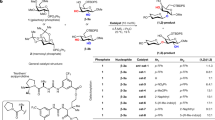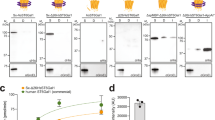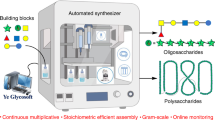Abstract
Contemporary chemoenzymatic approaches can provide highly complex multi-antennary N-linked glycans. These procedures are, however, very demanding and typically involve as many as 100 chemical steps to prepare advanced intermediates that can be diversified by glycosyltransferases in a branch-selective manner to give asymmetrical structures commonly found in nature. Only highly specialized laboratories can perform such syntheses, which greatly hampers progress in glycoscience. Here we describe a biomimetic approach in which a readily available bi-antennary glycopeptide can be converted in ten or fewer chemical and enzymatic steps into multi-antennary N-glycans that at each arm can be uniquely extended by glycosyltransferases to give access to highly complex asymmetrically branched N-glycans. A key feature of our approach is the installation of additional branching points using recombinant MGAT4 and MGAT5 in combination with unnatural sugar donors. At an appropriate point in the enzymatic synthesis, the unnatural monosaccharides can be converted into their natural counterpart, allowing each arm to be elaborated into a unique appendage.
This is a preview of subscription content, access via your institution
Access options
Access Nature and 54 other Nature Portfolio journals
Get Nature+, our best-value online-access subscription
$29.99 / 30 days
cancel any time
Subscribe to this journal
Receive 12 print issues and online access
$259.00 per year
only $21.58 per issue
Buy this article
- Purchase on Springer Link
- Instant access to full article PDF
Prices may be subject to local taxes which are calculated during checkout




Similar content being viewed by others
Data availability
All data related with this study are included in this article and the Supplementary Information, and also available from the authors upon request.
References
Moremen, K. W., Tiemeyer, M. & Nairn, A. V. Vertebrate protein glycosylation: diversity, synthesis and function. Nat. Rev. Mol. Cell Biol. 13, 448–462 (2012).
Ohtsubo, K. & Marth, J. D. Glycosylation in cellular mechanisms of health and disease. Cell 126, 855–867 (2006).
Lauc, G., Pezer, M., Rudan, I. & Campbell, H. Mechanisms of disease: the human N-glycome. Biochim. Biophys. Acta 1860, 1574–1582 (2016).
Hart, G. W. & Copeland, R. J. Glycomics hits the big time. Cell 143, 672–676 (2010).
Kiessling, L. L. & Splain, R. A. Chemical approaches to glycobiology. Annu. Rev. Biochem. 79, 619–653 (2010).
Cummings, R. D. & Pierce, J. M. The challenge and promise of glycomics. Chem. Biol. 21, 1–15 (2014).
Pilobello, K. T. & Mahal, L. K. Deciphering the glycocode: the complexity and analytical challenge of glycomics. Curr. Opin. Chem. Biol. 11, 300–305 (2007).
Wang, L. X. & Lomino, J. V. Emerging technologies for making glycan-defined glycoproteins. ACS Chem. Biol. 7, 110–122 (2012).
Hofmann, J. & Pagel, K. Glycan analysis by ion mobility-mass spectrometry. Angew. Chem. Int. Ed. 56, 8342–8349 (2017).
Hyun, J. Y., Pai, J. & Shin, I. The glycan microarray story from construction to applications. Acc. Chem. Res. 50, 1069–1078 (2017).
Wang, Z. et al. A general strategy for the chemoenzymatic synthesis of asymmetrically branched N-glycans. Science 341, 379–383 (2013).
Li, L. et al. Efficient chemoenzymatic synthesis of an N-glycan isomer library. Chem. Sci. 6, 5652–5661 (2015).
Li, T. et al. Divergent chemoenzymatic synthesis of asymmetrical-core-fucosylated and core-unmodified N-glycans. Chem. Eur. J. 22, 18742–18746 (2016).
Shivatare, S. S. et al. Modular synthesis of N-glycans and arrays for the hetero-ligand binding analysis of HIV antibodies. Nat. Chem. 8, 338–346 (2016).
Gagarinov, I. A. et al. Chemoenzymatic approach for the preparation of asymmetric bi-, tri- and tetra-antennary N-glycans from a common precursor. J. Am. Chem. Soc. 139, 1011–1018 (2017).
Schachter, H. & Freeze, H. H. Glycosylation diseases: quo vadis? Biochim. Biophys. Acta 1792, 925–930 (2009).
Kizuka, Y. & Taniguchi, N. Enzymes for N-glycan branching and their genetic and nongenetic regulation in cancer. Biomolecules 6, 25 (2016).
Cummings, R. D. The repertoire of glycan determinants in the human glycome. Mol. Biosyst. 5, 1087–1104 (2009).
Seko, A. et al. Occurence of a sialylglycopeptide and free sialylglycans in hen’s egg yolk. Biochim. Biophys. Acta 1335, 23–32 (1997).
Liu, L., Prudden, A. R., Bosman, G. P. & Boons, G. J. Improved isolation and characterization procedure of sialylglycopeptide from egg yolk powder. Carbohydr. Res. 452, 122–128 (2017).
Umekawa, M. et al. Efficient transfer of sialo-oligosaccharide onto proteins by combined use of a glycosynthase-like mutant of Mucor hiemalis endoglycosidase and synthetic sialo-complex-type sugar oxazoline. Biochim. Biophys. Acta 1800, 1203–1209 (2010).
Huang, W., Giddens, J., Fan, S. Q., Toonstra, C. & Wang, L. X. Chemoenzymatic glycoengineering of intact IgG antibodies for gain of functions. J. Am. Chem. Soc. 134, 12308–12318 (2012).
Maki, Y., Okamoto, R., Izumi, M., Murase, T. & Kajihara, Y. Semisynthesis of intact complex-type triantennary oligosaccharides from a biantennary oligosaccharide isolated from a natural source by selective chemical and enzymatic glycosylation. J. Am. Chem. Soc. 138, 3461–3468 (2016).
Alexander, S. R., Lim, D., Amso, Z., Brimble, M. A. & Fairbanks, A. J. Protecting group free synthesis of glycosyl thiols from reducing sugars in water; application to the production of N-glycan glycoconjugates. Org. Biomol. Chem. 15, 2152–2156 (2017).
Peng, W. et al. Recent H3N2 viruses have evolved specificity for extended, branched human-type receptors, conferring potential for increased avidity. Cell Host Microbe 21, 23–34 (2017).
Paschinger, K., Staudacher, E., Stemmer, U., Fabini, G. & Wilson, I. B. Fucosyltransferase substrate specificity and the order of fucosylation in invertebrates. Glycobiology 15, 463–474 (2005).
Voynow, J. A., Kaiser, R. S., Scanlin, T. F. & Glick, M. C. Purification and characterization of GDP-l-fucose-N-acetyl β-d-glucosaminide ɑ1→6fucosyltransferase from cultured human skin fibroblasts: equirement of a specific biantennary oligosaccharide as substrate. J. Biol. Chem. 266, 21572–21577 (1991).
Meng, L. et al. Enzymatic basis for N-glycan sialylation: structure of rat ɑ2,6-sialyltransferase (ST6GAL1) reveals conserved and unique features for glycan sialylation. J. Biol. Chem. 288, 34680–34698 (2013).
van den Eijnden, D. H., Blanken, W. M. & van Vliet, A. Branch specificity of β-d-galactosidase from Eschericha coli. Carbohydr. Res. 151, 329–335 (1986).
Choo, M. et al. Characterization of H type 1 and type 1 N-acetyllactosamine glycan epitopes on ovarian cancer specifically recognized by the anti-glycan monoclonal antibody mAb-A4. J. Biol. Chem. 292, 6163–6176 (2017).
Zauner, G., Deelder, A. M. & Wuhrer, M. Recent advances in hydrophilic interaction liquid chromatography (HILIC) for structural glycomics. Electrophoresis 32, 3456–3466 (2011).
Lauber, M. A., Koza, S. M. & Fountain, K. J. Optimization of GlycoWorks HILIC SPE for the Quantitative and Robust Recovery of N-linked Glycans from mAb-type Samples Waters Application Note 720004717EN (Waters Corporation, Milford, 2013).
Xu, Y. et al. Chemoenzymatic synthesis of homogeneous ultralow molecular weight heparins. Science 334, 498–501 (2011).
Antonopoulos, A. et al. Loss of effector function of human cytolytic T lymphocytes is accompanied by major alterations in N- and O-glycosylation. J. Biol. Chem. 287, 11240–11251 (2012).
Goddard-Borger, E. D. & Stick, R. V. An efficient, inexpensive and shelf-stable diazotransfer reagent: imidazole-1-sulfonyl azide hydrochloride. Org. Lett. 9, 3797–3800 (2007).
Bayley, H., Standring, D. N. & Knowles, J. R. Propane-1,3-dithiol—selective reagent for efficient reduction of alkyl and aryl azides to amines. Tetrahedron Lett. 19, 3633–3634 (1978).
Aoki, D., Appert, H. E., Johnson, D., Wong, S. S. & Fukuda, M. N. Analysis of the substrate binding sites of human galactosyltransferase by protein engineering. EMBO J. 9, 3171–3178 (1990).
Unverzagt, C. Chemoenzymatic synthesis of a sialylated undecasaccharide–asparagine conjugate. Angew. Chem. Int. Ed. Engl. 35, 2350–2353 (1996).
Hanashima, S., Manabe, S. & Ito, Y. Divergent synthesis of sialylated glycan chains: combined use of polymer support, resin capture-release and chemoenzymatic strategies. Angew. Chem. Int. Ed. 44, 4218–4224 (2005).
Jonke, S., Liu, K. G. & Schmidt, R. R. Solid-phase oligosaccharide synthesis of a small library of N-glycans. Chem. Eur. J. 12, 1274–1290 (2006).
Sun, B., Srinivasan, B. & Huang, X. F. Pre-activation-based one-pot synthesis of an ɑ-(2,3)-sialylated core-fucosylated complex type bi-antennary N-glycan dodecasaccharide. Chem. Eur. J. 14, 7072–7081 (2008).
Unverzagt, C. et al. Synthesis of multiantennary complex type N-glycans by use of modular building blocks. Chem. Eur. J. 15, 12292–12302 (2009).
Serna, S., Etxebarria, J., Ruiz, N., Martin-Lomas, M. & Reichardt, N. C. Construction of N-glycan microarrays by using modular synthesis and on-chip nanoscale enzymatic glycosylation. Chem. Eur. J. 16, 13163–13175 (2010).
Walczak, M. A. & Danishefsky, S. J. Solving the convergence problem in the synthesis of triantennary N-glycan relevant to prostate-specific membrane antigen (PSMA). J. Am. Chem. Soc. 134, 16430–16433 (2012).
Hamilton, B. S. et al. A library of chemically defined human N-glycans synthesized from microbial oligosaccharide precursors. Sci. Rep. 7, 15907 (2017).
Calderon, A. D. et al. An enzymatic strategy to asymmetrically branched N-glycans. Org. Biomol. Chem. 15, 7258–7262 (2017).
Maki, Y., Mima, T., Okamoto, R., Izumi, M. & Kajihara, Y. Semisynthesis of complex-type biantennary oligosaccharides containing lactosamine repeating units from a biantennary oligosaccharide isolated from a natural source. J. Org. Chem. 83, 443–451 (2018).
Prudden, A. R. et al. Synthesis of asymmetrical multiantennary human milk oligosaccharides. Proc. Natl Acad. Sci. USA 114, 6954–6959 (2017).
Cai, L. Recent progress in enzymatic synthesis of sugar nucleotides. J. Carbohydr. Chem. 31, 535–552 (2012).
Moremen, K. W. et al. Expression system for structural and functional studies of human glycosylation enzymes. Nat. Chem. Biol. 14, 156–162 (2018).
Muthana, S., Cao, H. & Chen, X. Recent progress in chemical and chemoenzymatic synthesis of carbohydrates. Curr. Opin. Chem. Biol. 13, 573–581 (2009).
Schmaltz, R. M., Hanson, S. R. & Wong, C. H. Enzymes in the synthesis of glycoconjugates. Chem. Rev. 111, 4259–4307 (2011).
Acknowledgements
This research was supported by the National Institute of General Medical Sciences (P01GM107012, P41GM103390 and U01GM120408 to G.-J.B. and K.W.M.) and the National Cancer Institute (F31CA180478 to A.R.P.) from the US National Institutes of Health. The content is solely the responsibility of the authors and does not necessarily represent the official views of the National Institutes of Health. The research benefitted from instrumentation provided by NIH grant S10 RR027097.
Author information
Authors and Affiliations
Contributions
L.L., A.R.P., C.J.C., K.W.M. and G.-J.B. designed research. L.L., A.R.P., C.J.C., G.P.B., D.G.C. and J.-Y.Y. performed research. D.G.C. and J.-Y.Y. contributed new reagents/analytic tools. L.L., A.R.P., C.J.C. and G.-J.B. wrote the paper.
Corresponding author
Ethics declarations
Competing interests
The authors declare no competing interests.
Additional information
Publisher’s note: Springer Nature remains neutral with regard to jurisdictional claims in published maps and institutional affiliations.
Supplementary information
Supplementary Information
Materials and Methods, Supplementary Figures 1-13, Supplementary Table 1 and NMR spectra
Rights and permissions
About this article
Cite this article
Liu, L., Prudden, A.R., Capicciotti, C.J. et al. Streamlining the chemoenzymatic synthesis of complex N-glycans by a stop and go strategy. Nature Chem 11, 161–169 (2019). https://doi.org/10.1038/s41557-018-0188-3
Received:
Accepted:
Published:
Issue Date:
DOI: https://doi.org/10.1038/s41557-018-0188-3
This article is cited by
-
Probing altered receptor specificities of antigenically drifting human H3N2 viruses by chemoenzymatic synthesis, NMR, and modeling
Nature Communications (2024)
-
Immobilized enzyme cascade for targeted glycosylation
Nature Chemical Biology (2024)
-
Chemoenzymatic synthesis of human natural killer-1-containing glycans and application as serum antibodies probes
Nature Synthesis (2023)
-
Chemoenzymatic synthesis of genetically-encoded multivalent liquid N-glycan arrays
Nature Communications (2023)
-
Cell surface glycan engineering reveals that matriglycan alone can recapitulate dystroglycan binding and function
Nature Communications (2022)



